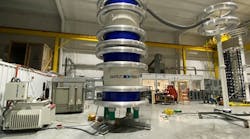A new thermal imaging technology can enhance the reliability and efficiency of the nation’s electric grid, according to manufacturer claims. Utility Risk Management Corp. has introduced Thermal Direct, which precisely measures conductor temperatures, enabling utilities to: improve system reliability and capacity; enhance the security of transmission assets; demonstrate compliance with applicable regulatory requirements; and reduce mitigation costs associated with compliance by as much as $2 billion dollars over a period of three years.
In recent testing confirmed by Electric Power Research Institute (EPRI) sensors, Thermal Direct’s accuracy presented a 95 percent confidence level, with residual error of only 3.75°F or 2.09°C.
“This technology is critical to an industry in which there is no room for error,” said Adam Rousselle, chief executive officer of URMC. “Precision in the measurement of conductor temperature has always been considered the holy grail for utilities. I am thrilled with our recent breakthrough and look forward to sharing it with transmission operators across the country.”
Current industry practice relies on calculating (vs. actually measuring) conductor temperature through a steady-state heat balance equation, which can generate significant margins of error due primarily to weather variables, such as wind and ambient temperature. In late 2010, the North American Electric Reliability Corp. (NERC) issued a regulatory alert requiring all transmission operators to assess within the next three years the precise physical characteristics of their high-voltage transmission lines relative to design specifications. Actual conductor temperature will be a leading indicator for NERC.
“After observing recent testing of this technology, I can confirm that it has the potential to be far more accurate and efficient than traditional calculation methods,” said Dale Douglass, principal engineer with Power Delivery Consultants, Inc. “It removes uncertainty and reduces the need for engineering conservatism, which could lead to higher line ratings.”

